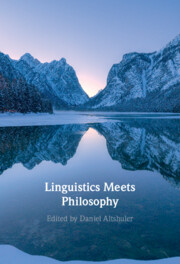Book contents
- Linguistics Meets Philosophy
- Linguistics Meets Philosophy
- Copyright page
- Contents
- Figures
- Tables
- Contributors
- Linguistics Meets Philosophy: A Historical Preface
- Introduction
- Part I Reporting and Ascribing
- Part II Describing and Referring
- Part III Narrating and Structuring
- Part IV Locating and Inferring
- Part V Typologizing and Ontologizing
- 9 A Typology of Semantic Entities
- 10 Nonfinite Verbal Forms and Natural Language Ontology
- Part VI Determining and Questioning
- Part VII Arguing and Rejecting
- Part VIII Implying and (Pre)supposing
- Index
- References
9 - A Typology of Semantic Entities
from Part V - Typologizing and Ontologizing
Published online by Cambridge University Press: 06 October 2022
- Linguistics Meets Philosophy
- Linguistics Meets Philosophy
- Copyright page
- Contents
- Figures
- Tables
- Contributors
- Linguistics Meets Philosophy: A Historical Preface
- Introduction
- Part I Reporting and Ascribing
- Part II Describing and Referring
- Part III Narrating and Structuring
- Part IV Locating and Inferring
- Part V Typologizing and Ontologizing
- 9 A Typology of Semantic Entities
- 10 Nonfinite Verbal Forms and Natural Language Ontology
- Part VI Determining and Questioning
- Part VII Arguing and Rejecting
- Part VIII Implying and (Pre)supposing
- Index
- References
Summary
The goal of this paper is to discuss which basic semantic entities we should include in our formal semantic ontology, and on which principles we should include them (cf. Bach 1986b). The vast majority of formal theories employ individuals as a basic type; they represent quantification over, modification of, and reference to individuals. But many theories include additional types or entities, including possible worlds, but also less common ones like vectors. Some papers have argued that types should be constrained or reduced; others that they should be proliferated. I present some representative arguments on both sides and suggest a path forward in evaluating them against one another.
Keywords
- Type
- Chapter
- Information
- Linguistics Meets Philosophy , pp. 277 - 301Publisher: Cambridge University PressPrint publication year: 2022



